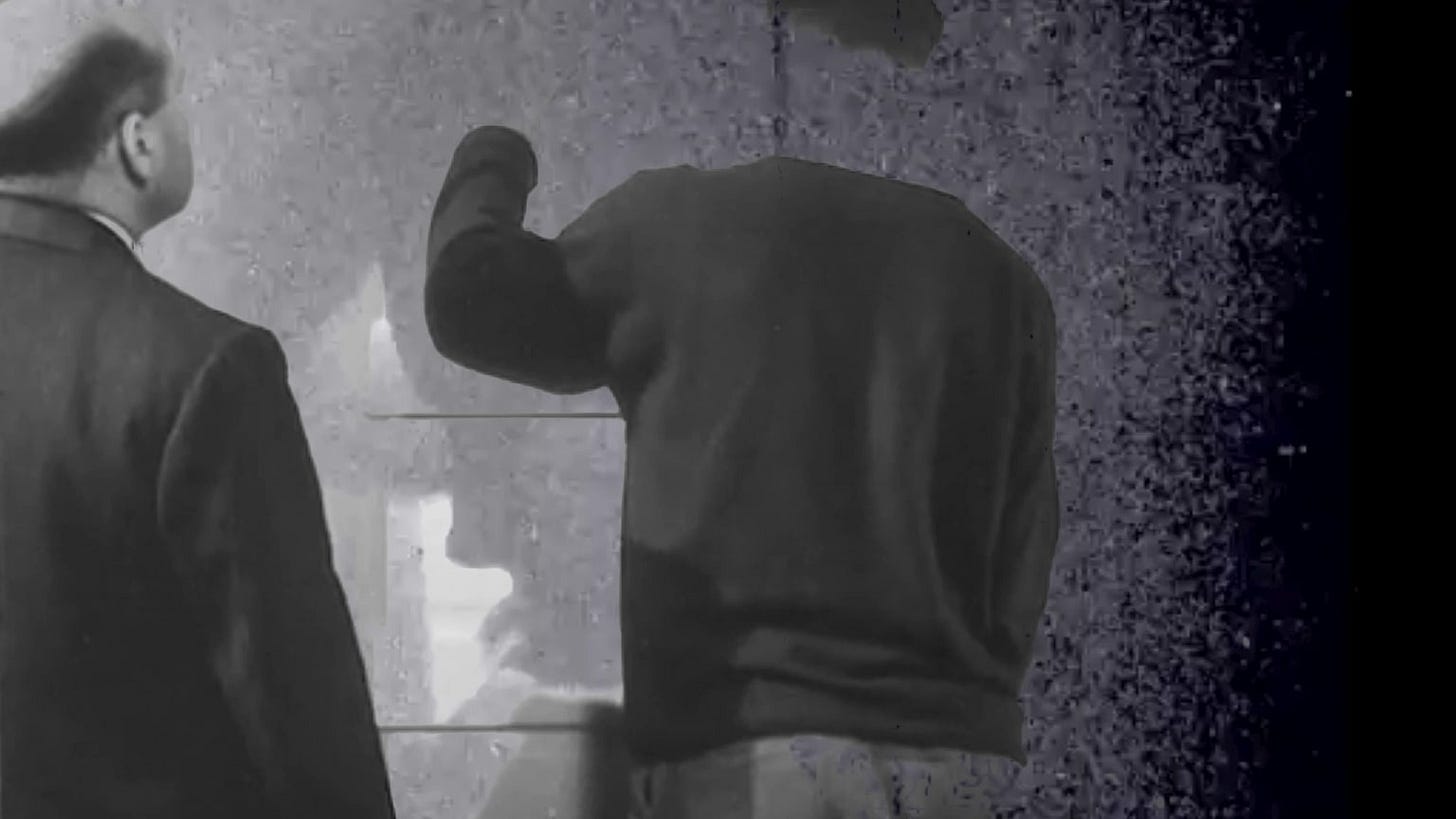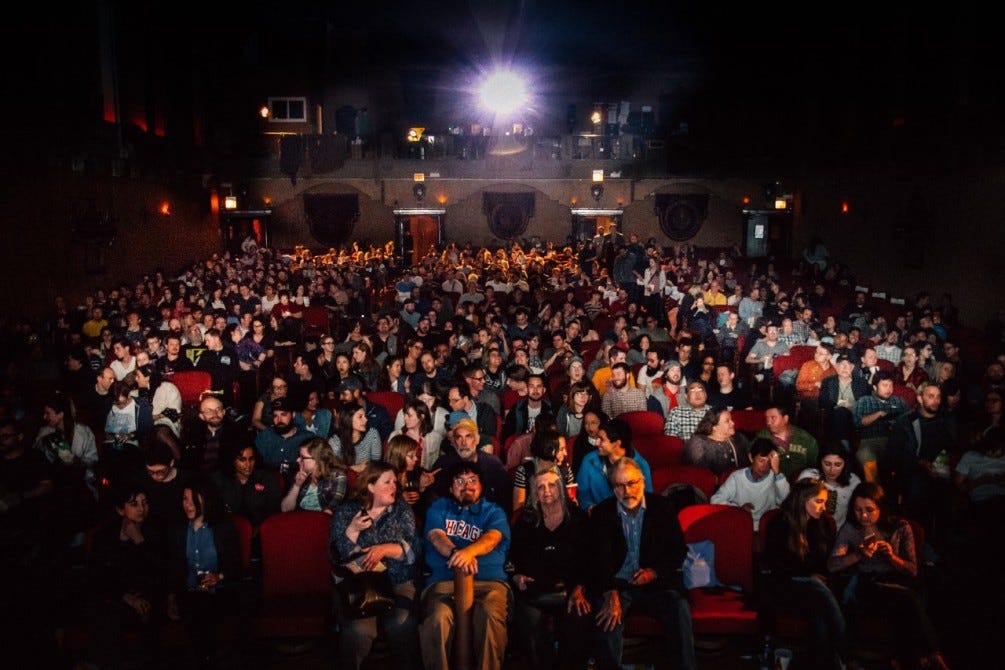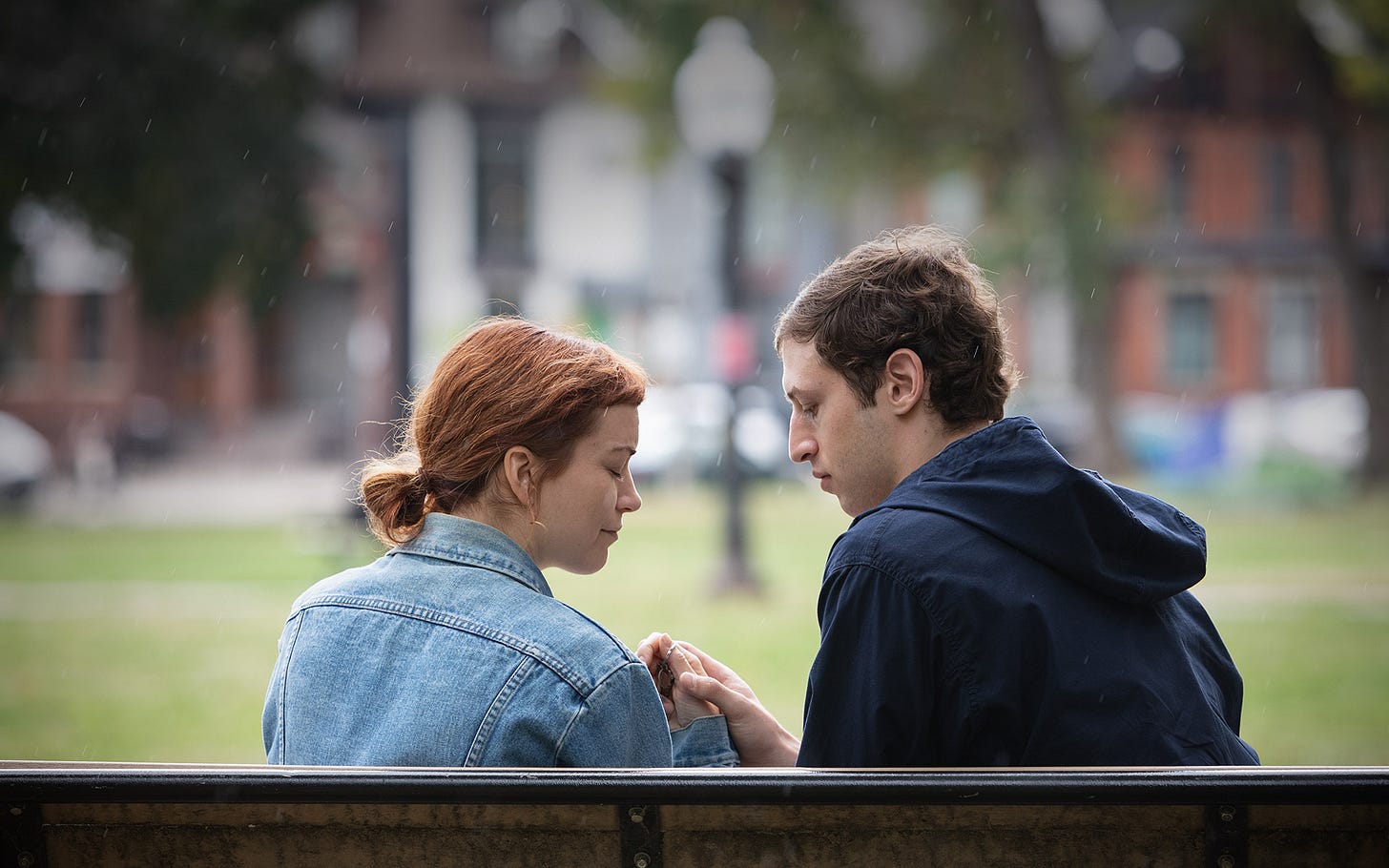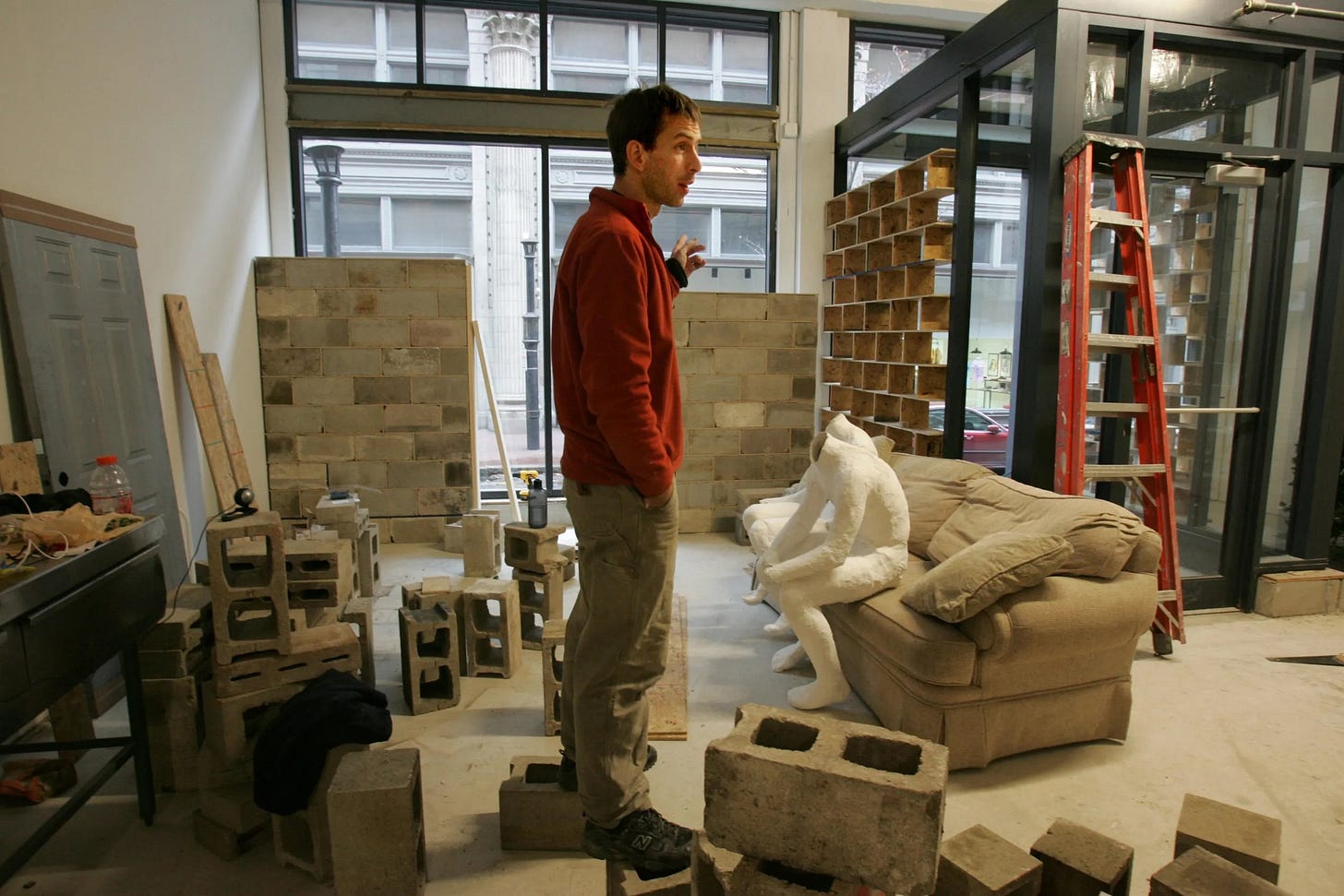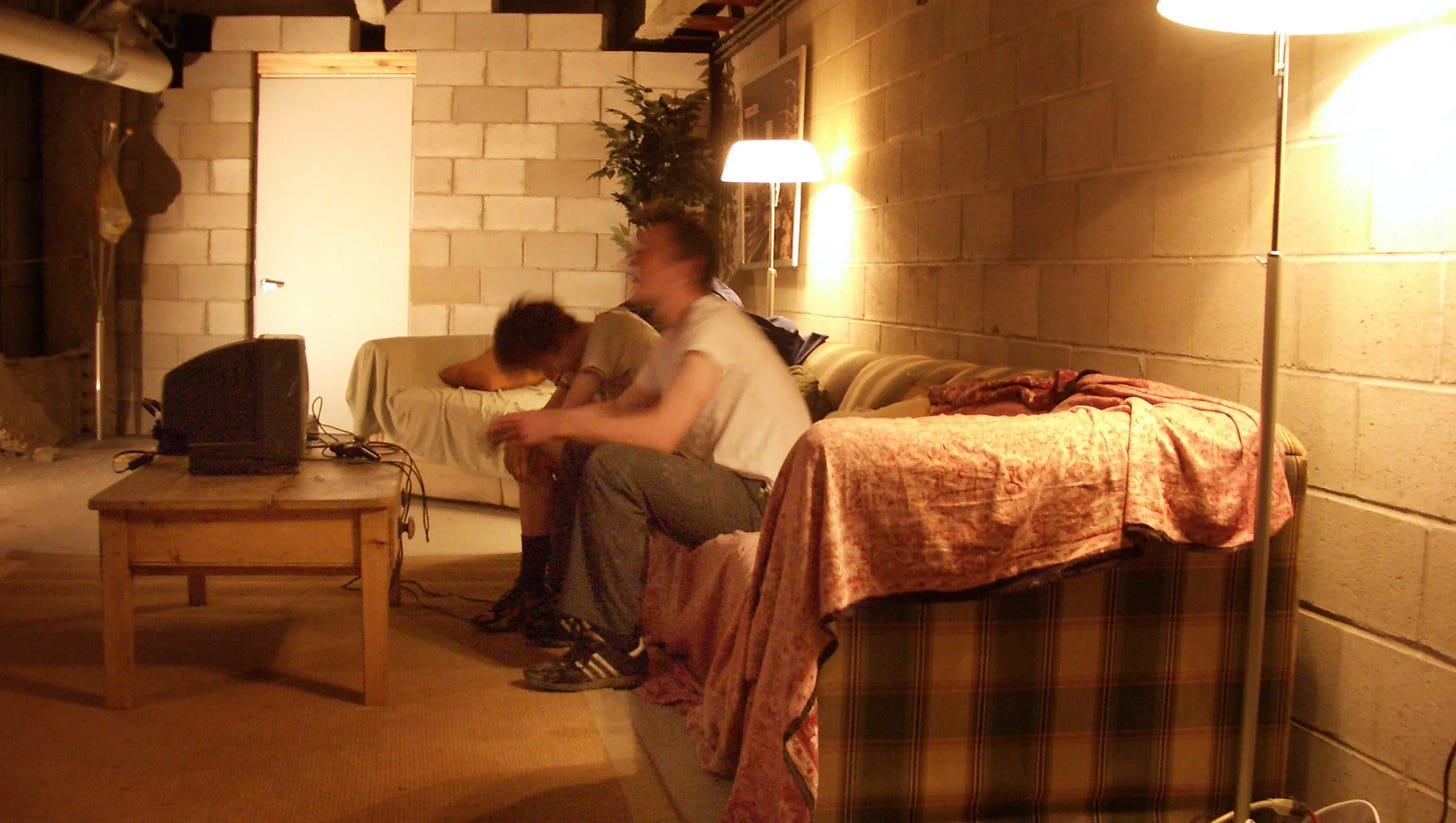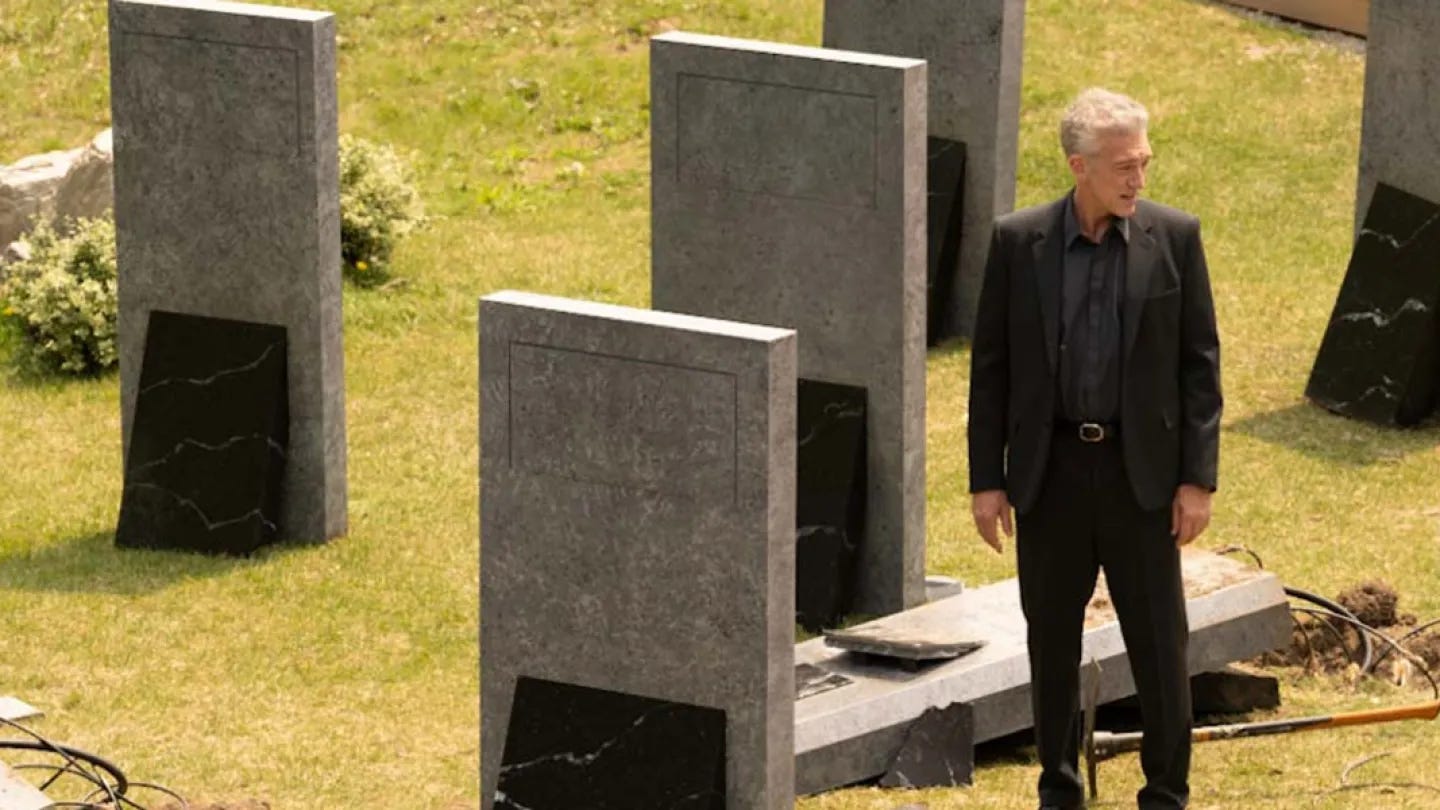New Reviews, CCFF, New Short Film!
Reviews of The Shrouds, Darkest Miriam and Secret Mall Apartment - along with my third short film, and links to get tickets for the Chicago Critics Film Festival!
Before we get to some new releases I reviewed, I decided to make one more experimental short film — The Past Is Here, all about mental health. It begins by sifting through archives of royalty-free video portraying mental illness and migraines — with the final shot capturing something deep and significant for me. Also this is the first time using someone else’s music that fit so well throughout. Feel free to view here, then log on Letterboxd. Only 6 minutes long:
Speaking of short films, my first one, The Switching Division, was chosen to play this film festival out in Vermont. What a tremendous honor. Unable to attend in person but hopefully there’s a way to view all the chosen films online or virtually.
Chicago Critics Film Festival Starts May 2nd!
Around my birthday each year, I take a week-long stay-cation to catch up on creative projects during the day, but at night, I head over to my favorite movie theater in Chicago to spend time watching films curated by colleagues / friends. I also cover as much as I can with capsule reviews of everything playing at the fest. Expect more coverage to come throughout the next month or so.
The Chicago Film Critics Association (CFCA), the Chicago-area print, online and broadcast critics group that celebrates the art of film and film criticism, recently announced the complete lineup for the Chicago Critics Films Festival, an event I always look forward to and you should definitely get passes/tickets right now!
The festival opens with a screening of The Baltimorons, with filmmaker Jay Duplass, co-writer/star Michael Strassner and star Liz Larsen scheduled to attend. The week-long event closes with Angus MacLachlan’s A Little Prayer, including MacLachlan, Jane Levy, David Strathairn scheduled to attend. There are plenty of titles I’m excited to see including Collin Souter’s shorts program.
Additional selected films for the 2025 festival include Chicago premieres of the most anticipated films of the year, including James Sweeney’s Twinless starring Dylan O’Brien and Lauren Graham; Sarah Friedland’s Familiar Touch; Friendship with Paul Rudd and A24’s Sorry, Baby with filmmaker and star Eva Victor scheduled to attend for the festival’s centerpiece screening. More information on the complete schedule and anticipated special guests is here at the CCFF website which I help to maintain and update: https://www.chicagocriticsfilmfestival.com
New Reviews
Darkest Miriam (dir. Naomi Jaye)
In Naomi Jaye's remarkable film, the seemingly mundane setting of a Toronto public library becomes the canvas for a profound exploration of interpersonal connection, grief, and the quiet mysteries that can transform our lives. Adapted from Martha Baillie's experimental novel The Incident Report, what could have been a conventional character study unfolds into something far more resonant and delicate. To be completely honest, I am a librarian, so this was bound to hit home regardless.
Miriam is at the center of the narrative, portrayed with remarkable subtlety and nuance by the incredible Britt Lower. Miriam is a librarian who moves through her days with a resigned, almost imperceptible heaviness. She catalogs the eccentric patrons who frequent her branch through written "incident reports" that serve as professional documentation and a way to maintain emotional distance from the world around her. As librarians, we know how to compartmentalize, chronicle, and organize in many different iterations. Please don’t ask me about my crazy collection of Google Docs.
It is like a journal but also a form of coming to terms with her working environment via this method of documentation. There are various regular patrons, such as "Suitcase Man," who always carries one, "Fainting Man," who often does, and "Unusually Pale Female Patron," each categorized and contained within Miriam's orderly system.
The film's narrative unfolds along two parallel tracks that gradually intersect. In one, Miriam strikes up a tentative romance with Janko (Tom Mercier), a Slovenian immigrant who works as a taxi driver while expressing himself through his art. Their connection develops with a warm, gentle authenticity that feels fragile and much needed. Mercier brings more of a sharp directness to Janko that perfectly complements Lower's restrained introvert, creating a chemistry that speaks volumes through minimal dialogue and careful gestures.
The second story line involves mysterious letters Miriam begins finding throughout the library, signed by someone calling themselves "Rigoletto" – a reference to the opera her father once took her to see. These cryptic messages, which seem to observe Miriam's movements with unsettling precision, introduce an element of psychological mystery that never quite resolves into conventional thriller territory.
Instead, they serve as a portal into Miriam's inner landscape, gradually revealing the grief she carries over her father's death – a loss she initially conceals from Janko, telling him her father is alive and selling insurance. There’s an incredible shot late in the film where father and daughter reflect and merge, bringing me to tears.
What distinguishes Darkest Miriam is Jaye's remarkable restraint as a filmmaker. She allows the camera to observe rather than intrude, creating a language that mirrors Miriam's careful observation of the world. The library becomes a character – a sanctuary of order amid chaotic behavior, a place where the marginalized find refuge, and Miriam can maintain an illusion of control.
When the film ventures outside, it's often to the beautiful Allan Gardens, where the conservatory's lush beauty starkly contrasts the harsh realities of urban life visible just beyond its glass walls. This dichotomy reflects Miriam's internal divisions.
Lower's performance is extraordinary since her actions, especially in the workplace, often reflect mine. With minimal dialogue, she conveys Miriam's complex emotional state through the subtlest shifts in expression and posture. A scene in a doctor’s clinic, where Miriam silently refuses to answer questions about suicidal thoughts, achieves a devastating emotional impact through Lower's unmoving face and pained eyes.
Her work here is a masterclass in restraint, allowing us to feel the depth of Miriam's pain without a single word being spoken. In a film chock-full of memorable scenes, that visit to a clinic is near the top. The film is not always overtly about mental health. Still, it’s there in the background, both within the aftereffect of being in that working environment and unable to open up or connect with others after clocking out for the day.
The most impressive thing about Darkest Miriam is how it resists easy categorization. It contains romance, psychological thriller, and ghost story elements, yet never fully commits to any genre. Perhaps some might find this unengaging or unfulfilling to leave open threads, but it doesn’t once take you out of the world it inhabits throughout.
This creates a unique emotional terrain, one where depression and hope, connection and isolation, reality and memory coexist in a delicate balance. The film builds to a revelation that re-contextualizes much of what came before, not as a twist for shock value but as a deeper understanding of Miriam's journey. Part of me wanted to know where the character goes from that point forward. That goes to show how much I was invested.
Executive produced by Charlie Kaufman (my favorite writer), Darkest Miriam shares some of his interest in the odd complexities of human psychology but employs a gentler, more naturalistic approach. Jaye's film is less concerned with bending reality in ways that Kaufman embodies rather than revealing the strange, sometimes surreal qualities of everyday life in librarianship. It suggests that the most profound mysteries aren't supernatural but deeply human – the ways we protect ourselves from pain, the connections we forge despite our fears, and the possibility of emerging from grief without leaving it entirely behind.
At a time when cinema often prioritizes spectacle and sensation, Darkest Miriam stands as a testament to the power of muted observation and emotional authenticity. It's a slow, involving film that trusts its audience to find meaning in silences, to piece together fragments of a life, and to recognize in Miriam's journey something universal about isolation and a need to connect with others. Like a library itself, the film creates a welcoming space where conflicted feelings that come from being lost and lonely are given the attention and compassion each of us deserves. I can’t stop thinking about it. It’s my favorite film of 2025 so far.
Secret Mall Apartment (dir. Jeremy Workman)
In the early 2000s, as Providence, Rhode Island underwent urban renewal centered around a gleaming new shopping center, a group of displaced artists embarked on what would become one of the most audacious art projects in recent memory. Jeremy Workman's documentary Secret Mall Apartment chronicles how eight artists, led by Michael Townsend, secretly built and maintained a fully-furnished apartment inside Providence Place Mall for four years without detection.
The premise sounds like fiction: artists smuggling furniture, electronics, and building materials into an unused 750-square-foot space within the mall's infrastructure, creating a living space complete with a couch, dining table, PlayStation 2, and even a custom door with a working lock. Yet through Townsend's remarkably comprehensive video documentation—captured on a small digital camera often hidden in a mint tin, we witness a wildly improbable story unfold with astonishing intimacy.
What begins as a seemingly juvenile prank evolves into something far more profound. The mall itself represents the gentrification that displaced these artists from their community spaces, including Fort Thunder, a beloved warehouse venue demolished to make way for commercial development. Their secret apartment becomes both protest and reclamation—a way to literally inhabit the belly of the capitalist beast that had swallowed their artistic community.
Workman wisely expands beyond the headline-grabbing concept to explore the broader artistic practices and philosophies of Townsend and his collaborators. We learn about Townsend's "tape art" installations in hospitals and his 9/11 memorial projects, revealing a consistent thread of ephemeral, community-focused work. These contextual elements elevate the film beyond mere urban exploration stunt documentation into a thoughtful meditation on art's purpose in society. Capitalism is crippling but this shows the promise of freedom by thinking outside the box and practicing the art of adaptation. Rules be damned.
The documentary's greatest strength lies in its access to the original participants, all interviewed for the first time about their involvement. Their reflections, paired with the grainy Y2K-era footage of their clandestine activities, create a compelling time capsule of a pre-surveillance era when such audacious interventions seemed possible.
The footage of the group maneuvering furniture up narrow maintenance staircases plays like a Laurel and Hardy routine, while their attempts to receive mail at the mall address highlight both their ingenuity and the absurdity of their situation. There are inevitable situations that arise like the residents pushing a couch and a nice living room cabinet up a narrow ladder and through a tiny crevasse into their new home. But it’s all in service of something greater for those involved here.
Secret Mall Apartment doesn't shy away from the project's complexities and contradictions. It acknowledges the privilege that allowed these predominantly white artists to move through the mall unquestioned by security. Undoubtedly, as someone who encounters those experiencing homelessness, I couldn’t help but think about the way certain people build little corners and homes simply just to survive. What I would like to see is the opportunity for anyone without a home to find one, built by dedicated volunteers in an urban setting.
It also explores the emotional weight of such a project, particularly through Townsend's relationship with his then-wife Adriana Valdez-Young, who eventually grows weary of their double life between mall apartment and home renovation. Workman's documentary arrives at a particularly interesting moment in time, as malls across America face extinction in the age of online shopping. One I frequented, River Oaks in Calumet City, IL, is a ghost town, non-existent.
Secret Mall Apartment poses provocative questions about public space, artistic resistance, and what constitutes meaningful art. Is a secret apartment in a mall merely a juvenile prank or a legitimate critique of consumer culture? The film suggests it's both—and that this contradiction is precisely what makes the experience of watching this so compelling. As one participant describes their collective as "an elite strike force team of empathetic artists," we understand both the seriousness and playfulness that animated their work.
For all its philosophical underpinnings, the documentary remains thoroughly entertaining and also conventionally presented for the most part. The heist-like elements of furniture smuggling, security evasion, and the creation of a functional living space provide constant tension and release. Workman balances these thrilling moments with thoughtful reflection, creating a documentary that satisfies both as entertainment and as sociological discourse.
Secret Mall Apartment celebrates the inspirational possibilities of community and creativity in the face of commercialization. It's a testament to art's power to carve out space—literally and figuratively—within systems designed to exclude it. In an era when genuine counter-cultural resistance seems increasingly difficult to imagine, this documentary reminds us that sometimes the most profound artistic statements happen in the spaces no one thought to look.
The Shrouds (dir. David Cronenberg)
David Cronenberg's latest film, The Shrouds, could very well be his most personal work to date—a haunting, darkly humorous, and occasionally bewildering exploration of grief, phone apps, and an obsession with monitoring mortality. It makes me want to reconsider my reaction to his take on Ballard’s Crash since this one worked for me in ways that one did not. Drawing from his own experience of losing his wife of 43 years in 2017, Cronenberg has crafted a slow, hypnotic film that feels both intimately autobiographical and distinctly aligned with his long-standing cinematic preoccupations of technology and intimacy.
Vincent Cassel stars as Karsh, a tech entrepreneur and founder of GraveTech who bears an unmistakable resemblance to Cronenberg himself—from the slicked-back gray hair to the measured, deadpan delivery. Following the death of his wife Becca (a fearless Diane Kruger) from bone cancer, Karsh has developed a revolutionary technology: shrouds embedded with HD cameras that wrap around corpses, allowing loved ones to monitor the decomposition process in real-time through an app or video screens embedded in headstones.
This macabre invention serves as the perfect Cronenbergian metaphor—computers/phones that connects us to and distances us from the physical reality of death. It’s also hard not to think of a parallel correlation involving sexual gratification for those who engage in watching porn (again another reason why I will revisit Crash). A subplot involves a group of activists that vandalize his cemetery and disable the feeds, including that of his beloved Becca, Karsh embarks on an increasingly paranoid investigation that spirals into a web of international conspiracies involving environmental protesters, Russian hackers, and Chinese surveillance.
Kruger delivers an award-worthy triple performance as Becca (seen in flashbacks and Karsh's necrophilic dreams), her identical twin sister Terry, and as the voice and model for Karsh's AI assistant Hunny. The actress navigates these roles with impressive nuance, particularly in her portrayal of Terry, whose relationship with Karsh evolves into something both inevitable and unsettling. Another great turn from Guy Pearce rounds out the main cast as Maury, Terry's ex-husband and Karsh's tech-savvy collaborator, though his twitchy, conspiracy-minded character feels somewhat underdeveloped especially when we learn what he’s done.
What distinguishes The Shrouds from Cronenberg's more overtly horrific works is a surprisingly subtle approach to its subject matter. While the film contains moments of the director's trademark body horror—particularly in its unflinching depiction of cancer's ravages on Becca's body—it's more concerned with the psychological horror of grief and the ways technology can both soothe and exacerbate our pain. The film's visual palette, courtesy of cinematographer Douglas Koch, is clinically pristine, creating a world that feels both familiar and slightly off-kilter, complemented by Howard Shore's subtly atmospheric score. All the elements of a great Cronenberg film are here, making this one of his best in quite a while.
The structure is deliberately disorienting, with dreams and reality bleeding into each other without clear demarcation. This approach mirrors the disorienting nature of grief itself but may frustrate viewers seeking a more coherent plot. Indeed, many of the conspiracy threads introduced throughout the film are left tantalizingly unresolved, suggesting that perhaps these elaborate theories are merely Karsh's attempt to impose meaning on the senseless reality of death.
The Shrouds is at its most compelling when it explores the intersection of death and desire (themes I love seeing being dissected). In a memorable scene, Karsh shows a blind date (Jennifer Dale) live footage of his wife's decomposing corpse—a moment that somehow manages to be both disturbing and darkly hilarious. Later, when Karsh and Terry finally consummate their attraction, she interrogates him about the anatomical differences between her and her sister, echoing similar conversations from Cronenberg's controversial 1996 film Crash. It’s one of the best scenes in a film chock-full of them.
The film's exploration of how capitalism commodifies grief is equally thought-provoking. Karsh has built an empire around death, complete with a luxury restaurant overlooking his cemetery. His technological innovation promises to revolutionize mourning, yet there's something fundamentally exploitative about the entire enterprise. Cronenberg seems to be suggesting that certain types of men—particularly those of a certain age and privilege—will always find ways to profit from human suffering, even their own.
Despite thematic richness, The Shrouds occasionally feels a bit languid and a tad bit longer than it needs to be. Cassel's performance, while an effective stand-in for Cronenberg himself, can come across as leaden, and the film's abrupt ending may leave audiences wanting more resolution. Though I love the thoughts it left me with regardless. There's also a sense that possibly the film might have benefited from its originally planned format as a two-part Netflix series, allowing more room to explore its numerous narrative threads.
The Shrouds remains a fascinating addition to Cronenberg's incomparable filmography. Again, I do think it’s one of his best films in quite a while despite having a couple of imperfections that keep it from being top tier. It may lack the visceral impact of his earlier body horror classics, but it compensates with emotional depth and philosophical inquiry. The film asks profound questions about how we process loss in the digital age, where the dead can remain perpetually present through technology and online archives, and whether such innovations help us heal or merely prolong our suffering.
In the end, The Shrouds stands as a deeply compelling meditation on mortality from a filmmaker who has spent his career examining the relationship between technology, the body, and the human psyche. It's a testament to Cronenberg's continued relevance and artistic vitality that, even after five decades of filmmaking, he can still create work that feels both familiar and exciting. If it ends up being his last feature, it would be a perfect note to go out on.





